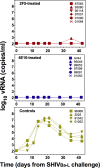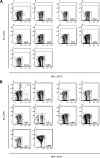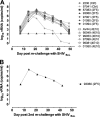Broadly neutralizing monoclonal antibodies 2F5 and 4E10 directed against the human immunodeficiency virus type 1 gp41 membrane-proximal external region protect against mucosal challenge by simian-human immunodeficiency virus SHIVBa-L
- PMID: 19906907
- PMCID: PMC2812338
- DOI: 10.1128/JVI.01272-09
Broadly neutralizing monoclonal antibodies 2F5 and 4E10 directed against the human immunodeficiency virus type 1 gp41 membrane-proximal external region protect against mucosal challenge by simian-human immunodeficiency virus SHIVBa-L
Abstract
The membrane-proximal external region (MPER) of HIV-1, located at the C terminus of the gp41 ectodomain, is conserved and crucial for viral fusion. Three broadly neutralizing monoclonal antibodies (bnMAbs), 2F5, 4E10, and Z13e1, are directed against linear epitopes mapped to the MPER, making this conserved region an important potential vaccine target. However, no MPER antibodies have been definitively shown to provide protection against HIV challenge. Here, we show that both MAbs 2F5 and 4E10 can provide complete protection against mucosal simian-human immunodeficiency virus (SHIV) challenge in macaques. MAb 2F5 or 4E10 was administered intravenously at 50 mg/kg to groups of six male Indian rhesus macaques 1 day prior to and again 1 day following intrarectal challenge with SHIV(Ba-L). In both groups, five out of six animals showed complete protection and sterilizing immunity, while for one animal in each group a low level of viral replication following challenge could not be ruled out. The study confirms the protective potential of 2F5 and 4E10 and supports emphasis on HIV immunogen design based on the MPER region of gp41.
Figures






Similar articles
-
An affinity-enhanced neutralizing antibody against the membrane-proximal external region of human immunodeficiency virus type 1 gp41 recognizes an epitope between those of 2F5 and 4E10.J Virol. 2007 Apr;81(8):4033-43. doi: 10.1128/JVI.02588-06. Epub 2007 Feb 7. J Virol. 2007. PMID: 17287272 Free PMC article.
-
Anti-human immunodeficiency virus type 1 (HIV-1) antibodies 2F5 and 4E10 require surprisingly few crucial residues in the membrane-proximal external region of glycoprotein gp41 to neutralize HIV-1.J Virol. 2005 Jan;79(2):1252-61. doi: 10.1128/JVI.79.2.1252-1261.2005. J Virol. 2005. PMID: 15613352 Free PMC article.
-
Binding of anti-membrane-proximal gp41 monoclonal antibodies to CD4-liganded and -unliganded human immunodeficiency virus type 1 and simian immunodeficiency virus virions.J Virol. 2012 Feb;86(3):1820-31. doi: 10.1128/JVI.05489-11. Epub 2011 Nov 16. J Virol. 2012. PMID: 22090143 Free PMC article.
-
Antigp41 membrane proximal external region antibodies and the art of using the membrane for neutralization.Curr Opin HIV AIDS. 2017 May;12(3):250-256. doi: 10.1097/COH.0000000000000364. Curr Opin HIV AIDS. 2017. PMID: 28422789 Review.
-
The membrane-proximal external region of the human immunodeficiency virus type 1 envelope: dominant site of antibody neutralization and target for vaccine design.Microbiol Mol Biol Rev. 2008 Mar;72(1):54-84, table of contents. doi: 10.1128/MMBR.00020-07. Microbiol Mol Biol Rev. 2008. PMID: 18322034 Free PMC article. Review.
Cited by
-
Broadly neutralizing antibodies potently inhibit cell-to-cell transmission of semen leukocyte-derived SHIV162P3.EBioMedicine. 2020 Jul;57:102842. doi: 10.1016/j.ebiom.2020.102842. Epub 2020 Jun 30. EBioMedicine. 2020. PMID: 32619962 Free PMC article.
-
Highly potent HIV-specific antibody neutralization in vitro translates into effective protection against mucosal SHIV challenge in vivo.Proc Natl Acad Sci U S A. 2012 Nov 13;109(46):18921-5. doi: 10.1073/pnas.1214785109. Epub 2012 Oct 25. Proc Natl Acad Sci U S A. 2012. PMID: 23100539 Free PMC article.
-
Identification of HIV gp41-specific antibodies that mediate killing of infected cells.PLoS Pathog. 2019 Feb 19;15(2):e1007572. doi: 10.1371/journal.ppat.1007572. eCollection 2019 Feb. PLoS Pathog. 2019. PMID: 30779811 Free PMC article.
-
Oral Immunization with HIV-1 Envelope SOSIP trimers elicits systemic immune responses and cross-reactive anti-V1V2 antibodies in non-human primates.PLoS One. 2020 May 29;15(5):e0233577. doi: 10.1371/journal.pone.0233577. eCollection 2020. PLoS One. 2020. PMID: 32470041 Free PMC article.
-
Early preservation of CXCR5+ PD-1+ helper T cells and B cell activation predict the breadth of neutralizing antibody responses in chronic HIV-1 infection.J Virol. 2014 Nov;88(22):13310-21. doi: 10.1128/JVI.02186-14. Epub 2014 Sep 10. J Virol. 2014. PMID: 25210168 Free PMC article.
References
-
- Baba, T. W., V. Liska, R. Hofmann-Lehmann, J. Vlasak, W. Xu, S. Ayehunie, L. A. Cavacini, M. R. Posner, H. Katinger, G. Stiegler, B. J. Bernacky, T. A. Rizvi, R. Schmidt, L. R. Hill, M. E. Keeling, Y. Lu, J. E. Wright, T. C. Chou, and R. M. Ruprecht. 2000. Human neutralizing monoclonal antibodies of the IgG1 subtype protect against mucosal simian-human immunodeficiency virus infection. Nat. Med. 6:200-206. - PubMed
-
- Binley, J. M., T. Wrin, B. Korber, M. B. Zwick, M. Wang, C. Chappey, G. Stiegler, R. Kunert, S. Zolla-Pazner, H. Katinger, C. J. Petropoulos, and D. R. Burton. 2004. Comprehensive cross-clade neutralization analysis of a panel of anti-human immunodeficiency virus type 1 monoclonal antibodies. J. Virol. 78:13232-13252. - PMC - PubMed
-
- Buchacher, A., R. Predl, K. Strutzenberger, W. Steinfellner, A. Trkola, M. Purtscher, G. Gruber, C. Tauer, F. Steindl, A. Jungbauer, et al. 1994. Generation of human monoclonal antibodies against HIV-1 proteins; electrofusion and Epstein-Barr virus transformation for peripheral blood lymphocyte immortalization. AIDS Res. Hum. Retroviruses 10:359-369. - PubMed
-
- Casimiro, D. R., F. Wang, W. A. Schleif, X. Liang, Z. Q. Zhang, T. W. Tobery, M. E. Davies, A. B. McDermott, D. H. O'Connor, A. Fridman, A. Bagchi, L. G. Tussey, A. J. Bett, A. C. Finnefrock, T. M. Fu, A. Tang, K. A. Wilson, M. Chen, H. C. Perry, G. J. Heidecker, D. C. Freed, A. Carella, K. S. Punt, K. J. Sykes, L. Huang, V. I. Ausensi, M. Bachinsky, U. Sadasivan-Nair, D. I. Watkins, E. A. Emini, and J. W. Shiver. 2005. Attenuation of simian immunodeficiency virus SIVmac239 infection by prophylactic immunization with DNA and recombinant adenoviral vaccine vectors expressing Gag. J. Virol. 79:15547-15555. - PMC - PubMed
-
- Cline, A. N., J. W. Bess, M. Piatak, Jr., and J. D. Lifson. 2005. Highly sensitive SIV plasma viral load assay: practical considerations, realistic performance expectations, and application to reverse engineering of vaccines for AIDS. J. Med. Primatol 34:303-312. - PubMed
Publication types
MeSH terms
Substances
Grants and funding
LinkOut - more resources
Full Text Sources
Other Literature Sources

